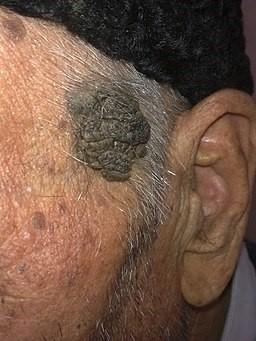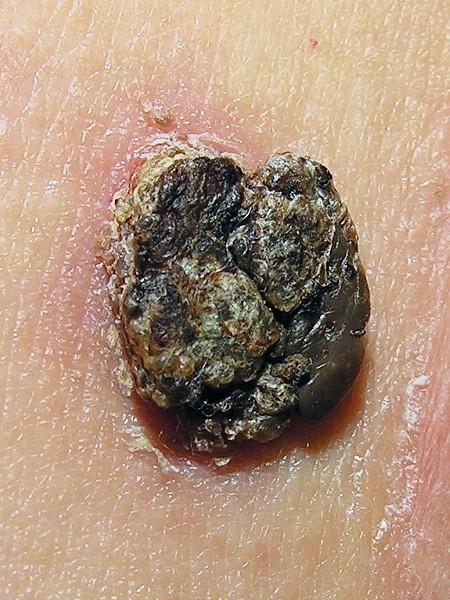Seborrhoeic warts
Peer reviewed by Dr Doug McKechnie, MRCGPLast updated by Dr Colin Tidy, MRCGPLast updated 19 Jul 2024
Meets Patient’s editorial guidelines
- DownloadDownload
- Share
- Language
- Discussion
In this series:Warts and verrucas
Seborrhoeic warts are non-cancerous (benign) warty growths that occur on the skin. They usually do not need any treatment.
In this article:
Continue reading below
What are seborrhoeic warts?
Seborrhoeic warts are also known as seborrhoeic keratoses or basal cell papillomas. In the past they were also called senile warts.
They usually look like greasy or crusty spots which seem to be stuck on to the skin. The colour varies but usually they are darkish brown or black. Seborrhoeic warts can occur almost anywhere on the body, but particularly on the face, chest, scalp, back and groin.
Dermatosis papulosa nigra are multiple, small, 1–5 mm diameter, smooth, firm, black or dark brown papules on face and neck. They common in people with darker skin tones. Their appearance is identical to small seborrhoeic warts.
What do seborrheic warts look like?
They are usually round although they can also be oval in shape. Some seborrhoeic warts have an irregular shape. Their size can vary from around one centimetre to several centimetres in diameter.
Black pigmented verrucous lesion

By Alborz Fallah (Own work), CC BY-SA 3.0, via Wikimedia Commons
Seborrhoeic keratosis

By Lmbuga (Own work), Public domain, via Wikimedia Commons
Continue reading below
What causes seborrheic warts?
Seborrhoeic warts tend first to appear around the age of 40. They can sometimes run in families. The actual cause of seborrhoeic warts is unknown. It can be common to develop several seborrhoeic warts as you become older. Also, as time goes by, each wart tends to grow slightly and become darker. They can occur anywhere on your body, other than on your palms or soles, and there may be multiple lesions.
Are seborrhoeic warts serious?
No. Seborrhoeic warts are always benign. That means they do not spread and they are not cancerous. The main problem is that they can sometimes look unsightly, particularly if they develop on your face.
However, rarely, seborrhoeic warts may be associated with various cancers. The Leser-Trélat sign is rare and refers to the sudden appearance of multiple seborrhoeic warts. This sign is associated with a number of different cancers, particularly bowel, breast, or stomach, and has also been associated with cancers of the liver, kidney and pancreas.
Very rare cases have been reported of a type of skin cancer called melanoma developing within a seborrhoeic wart. It is not known if this is just a coincidence or whether it represents a true cancer change in the seborrheic wart. If you do notice a change in a seborrhoeic wart, it is worth asking your doctor to examine it.
Note: although they are called warts, they are not caused by the wart virus. They are not infectious.
Continue reading below
How are seborrhoeic warts diagnosed?
Doctors can often diagnose seborrhoeic warts by their appearance. However, if there is any doubt about the diagnosis, especially if the possibility of a more serious diagnosis such as skin cancer is suspected, then dermatoscopy may be used for a closer look at the structure of the lesion.
Dermatoscopy is a technique to examine the skin with a magnifying lens and a light. It can help diagnose skin lesions by accurate assessment of their colour, structures, patterns and borders.
Sometimes a biopsy or removal of the lesion may be needed so that the diagnosis can be confirmed by the detailed structure of the lesion (histology).
What is the treatment for seborrhoeic warts?
If they do not cause any problems then it is best that they be left alone. Without treatment, they usually continue to grow and can become darker and more crusty. However, they do increase in size very slowly.
If required, however, they can be removed quite easily. Seborrhoeic warts are usually removed because they itch, they interfere with clothing or jewellery or they are unsightly.
Two commonly used methods to remove them are:
By using a curette. This involves 'freezing' the surrounding skin with local anaesthetic. The seborrhoeic warts are then scraped off with a sharp surgical instrument called a curette.
Liquid nitrogen treatment. Liquid nitrogen is very cold and anything it touches is killed by the cold. Small amounts of liquid nitrogen can be sprayed on to small seborrhoeic warts. The seborrhoeic warts are killed and drop off a few days later. Normal skin replaces the area left behind. Liquid nitrogen is not suitable for larger warts.
Once seborrhoeic warts have been removed, they usually do not return.
Complications of seborrhoeic warts
Seborrhoeic warts do not become cancerous and are benign, unless there is a sudden appearance of multiple seborrhoeic warts, which may be associated with various cancers (see Leser-Trélat sign above).
Seborrhoeic warts way cause minor local complications such as infection, bleeding or surrounding dermatitis (eczema).
Patient picks for Other skin problems

Skin, nail and hair health
Pressure sores
A pressure sore is also known as a 'bed sore' or a 'pressure ulcer'. It is a sore or broken (ulcerated) area of skin caused by irritation and continuous pressure on part of your body. Pressure sores are more common over places where your bones are close to your skin (bony prominences) such as your heels, the lower part of your back and your bottom. There are various things that can increase your risk of developing a pressure sore. In particular, risk increases if your mobility is reduced for some reason and you are spending long periods lying in bed or sitting in a chair. There are various measures you can take to prevent most pressure sores developing. These include changing your position as much as possible and also using pressure-relieving devices.
by Dr Hayley Willacy, FRCGP

Skin, nail and hair health
Lipoma
A lipoma is a non-cancerous (benign) fatty lump that usually causes no symptoms or problems. Most lipomas are small and can be left alone. However, a lipoma that develops under the skin can sometimes look unsightly. If required, it can be removed by a simple operation done under local anaesthetic.
by Dr Doug McKechnie, MRCGP
Further reading and references
- Seborrheic Keratosis; DermIS (Dermatology Information System)
- Seborrhoeic Keratoses; DermNet NZ
- Seborrhoeic keratosis; Primary Care Dermatology Society
Continue reading below
Article history
The information on this page is written and peer reviewed by qualified clinicians.
Next review due: 18 Jul 2027
19 Jul 2024 | Latest version

Ask, share, connect.
Browse discussions, ask questions, and share experiences across hundreds of health topics.

Feeling unwell?
Assess your symptoms online for free
Sign up to the Patient newsletter
Your weekly dose of clear, trustworthy health advice - written to help you feel informed, confident and in control.
By subscribing you accept our Privacy Policy. You can unsubscribe at any time. We never sell your data.